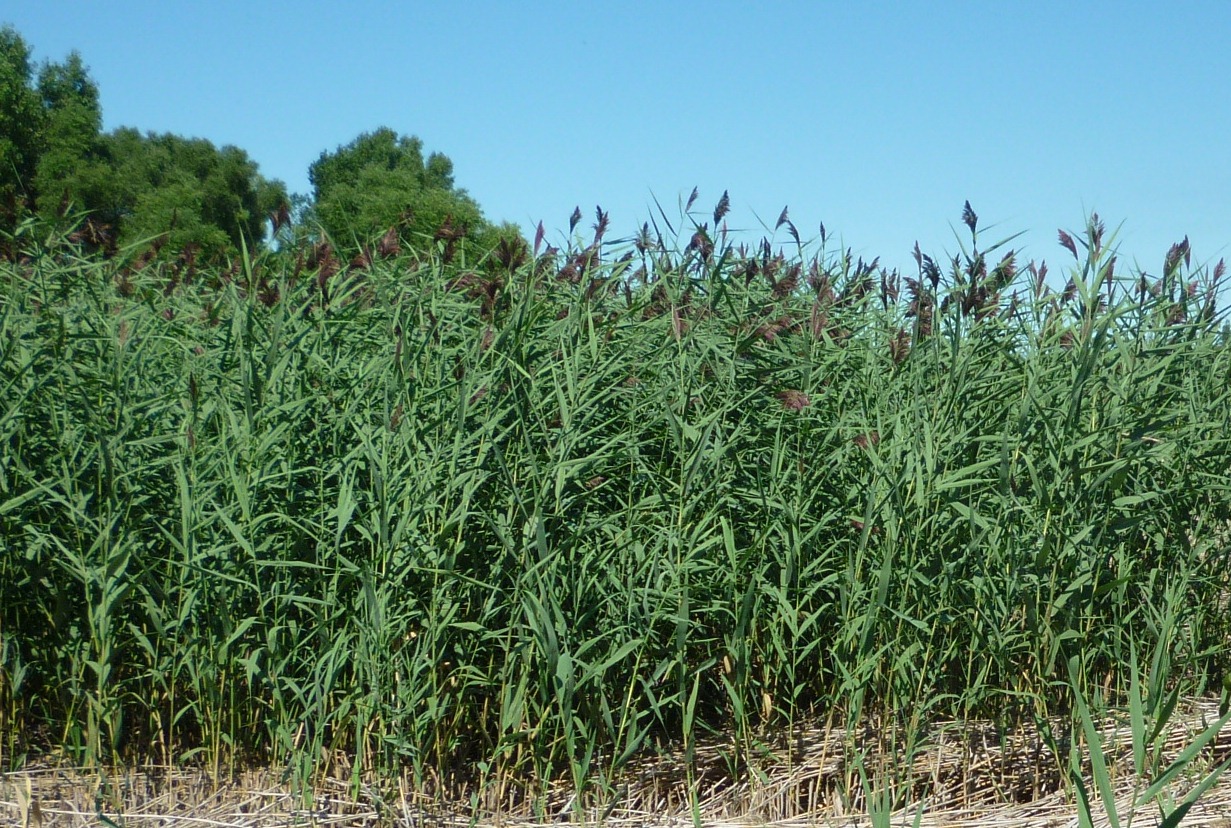
I wrote an article warning of the spread of this invasive terrestrial in the 2012 yearbook. That article was a bit premature but this year, we need to watch out for and eradicate any new stands of this nasty reed in our area. This will help to reduce the number of new incursions and therefore the rapid spread of this invasive.
Invasive European Common Reed (Phragmites australis), pronounced “frag-my-teeze”, has been categorized as an aggressive invasive species and is rapidly spreading along shorelines in the Great Lakes. It has been identified around the Parry Sound area and anecdotally it has appeared as far north as Bay of Islands (unconfirmed). I worry that it is in the Pointe au Baril area already but has not been identified at the immature stages of growth.
Invasive phragmites chokes out native species (the root releases a chemical that negatively affects the growth and survival of competing plants), hampers biodiversity (it provides little to no habitat for birds, small mammals, reptiles and amphibians) and blocks access and views to shorelines (it grows to heights of 5 metres or 15 feet). It grows in wet areas, ditches, wetlands, marshes and beaches. It spreads both above and below ground: above through dispersal of its seeds via wind, water or tracking and below via underground growth of the root or rhizome.
You have probably noticed tall stands of invasive phragmites growing along the 400 series highways. Some of these mature stands have already formed “fences” along the sides of highways 400 and 407. The GTA municipalities where the stands are established have done little to eradicate this terrestrial invader and it is easy to understand how it has spread so quickly up highway 400 (in tire treads, etc.) and along the shorelines of the Great Lakes.
Invasive phragmites is similar to our native Phragmites Americanus so it is imperative to confirm identification of the invasive variety. This can be done by reporting sightings to EDDMapS at www.eddmaps.org/Ontario/report/index.cfm. You will need to provide your contact information but it will only be used to follow up with you about your reports if needed. This is the best upload site for mapping as it will get into the official provincial record system and the information will be public. There is also a smart phone app for Iphone/Ipads and Androids. This enables you to “See it and Map it” through EDDMapS (Early Detection & Distribution Mapping System). You can submit your invasive species observation directly from your phone and reports are uploaded and emailed directly to verifiers for review.
Telling the Difference Between Native and Invasive Phragmites
How can you tell the difference between native phragmites and invasive phragmites? First of all, our native stands are interspersed with other plant and tree species such as cardinal flowers, small pines and other native weeds and grasses. As you can see in the photo, small, native phragmites seed heads in the foreground of the photo show the plant co-exiting with other species. Invasive phragmites out-competes other species of plants and becomes a “monoculture”. Please read the chart below to become familiar with the important differences between our native and the invasive phragmites.
CHARACTERISTIC NATIVE PHRAGMITES INVASIVE PHRAGMITES
|
Stand Height |
Up to 2 metres (6 ft) |
Up to 5 metres (16 ft) |
|
Stand Density |
Sparse, interspersed with native vegetation |
Dense monoculture, up to 100% invasive phragmites |
|
Stem Colour |
Turn reddish in spring and summer |
Green and tan in spring/summer |
|
Stem Texture |
Smooth and shiny; lower leaves fall off easily |
Rough and dull; lower leaves tend to stay attached |
|
Stem Flexibility |
Very flexible |
Rigid |
|
Leaf Colour |
Yellow-green |
Blue-green |
|
Leaf Appearance |
Narrow; leaves grow about 30° from the stem; few to no hairs where leaf meets the stem |
Wide; leaves grow about 45° from the stem; small dense hairs where leaf meets the stem |
|
Seedhead Density |
Sparse, small; flower early in July-August |
Dense, large; flower in August-September |
Note that young stands of invasive phragmites might be harder to identify, as they usually don’t produce seed heads until the stand is denser and well established.
How does one remove a stand of invasive phragmites from their property? Since no herbicides are licensed in Canada for use over-water, chemicals cannot be used for safe removal. Careful cutting, bagging and possible disposal or burning of cut debris will be the best method. Annual maintenance is necessary, as it will take a few seasons to eradicate. When cutting and bagging for disposal, you need to be vigilant that no pieces of the plants are left to transplant themselves and start a new growth stand. In my report in the 2012 yearbook, I advised that invasive phragmites could be bagged and taken to Site 9 for disposal as long as it was identified at drop off. However, the TOA is currently updating their protocol on disposal and it is not available at this time. PaBIA will keep members informed through Connections Newsletters and weekly eBlasts in the summer.
GBA has been networking with experts across the Province to learn what they can about this invasive plant and how best to try to deal with it. They are bringing some of these experts together at a workshop on April 25th in Toronto in order for members to learn firsthand what we are up against. There will be experts at the workshop who have had considerable experience dealing with it through multiple growth cycles or seasons. GBA plans to provide member associations with a protocol on how best to gather volunteers in our communities to identify and remove invasive phragmites. Stay tuned for updates!!
If you are interested in getting involved as a removal volunteer, please contact Sandy Boeckh at [email protected].